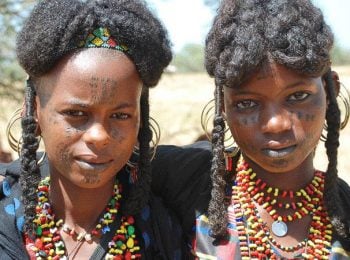The Gerewol Festival & Ennedi Mountains
This is an epic trip through one of our favourite destinations, combining the colourful tribal life of Chad with the awe-inspiring splendour of the Sahara desert.
Each year the semi-nomadic Wodaabe people gather for a week of incredible celebrations known as the Gerewol. This vibrant festival is one of Africa’s most spectacular. Few westerners are privileged to see this, but with our exceptional local contacts, we travel to a remote part of the Sahel to stay with these intensely traditional people, joining them as they congregate for feasting, racing, dancing and finding lovers.
The Gerewol is renowned for the way in which young Wodaabe men decorate themselves, donning makeup and jewellery and ‘displaying’ to young women in search of a partner. We immerse ourselves in a culture that lives very much outside of mainstream society. With traditions that stretch back centuries, this is a unique opportunity to meet the Wodaabe for a celebration of their culture that will simply take your breath away. Africa is known for its festivals, but few – if any – can rival the Gerewol.
The second and third weeks of this trip have a different flavour as we venture into the Sahara. Departing from N’Djamena we quickly leave the tarmac roads behind and start travelling through the Sahel. We pass through small settlements where our presence is a complete surprise to local people. We stop to pick up supplies and draw water at wells, often meeting Keraida nomad families with their camels.
After stocking up in the market of Kalait we drive into the Ennedi, a vast collection of sandstone mountains sculpted by the wind and sand over millennia into stunning rock formations. Here we enter the land of the Tubu, one of Africa’s most traditional and least known people. Our excellent local connections give us good opportunities to meet these rather shy and secretive people.
We look for rock art dating back thousands of years and walk into the Guelta d’Archei where the Tubu bring huge herds of camels to drink at the only waterhole for miles around. We may be lucky enough to spot one of the last populations of Saharan crocodiles.
Moving on we cross the dunes of the Mourdi depression on our way to the village of Demi, an important point for the trade in salt. We then head to the Ounianga Lakes, where the desert opens up to reveal a series of multi-hued lakes. This is an almost unbelievable sight after our journey through the sands.
After spending time exploring here and meeting local people, we turn to travel south, once more crossing dunes and often passing camel caravans on their way to the settled villages of the Ouaddai. On the way back from Kalait we travel through the Bahr el Ghazal region. There are surprising opportunities here to spot wildlife with gazelle, fennec fox and bustard often seen.
This is travel at its most exciting – raw, untamed, surprising and exhilarating. Join us to see why we are so in love with this spellbinding land.












